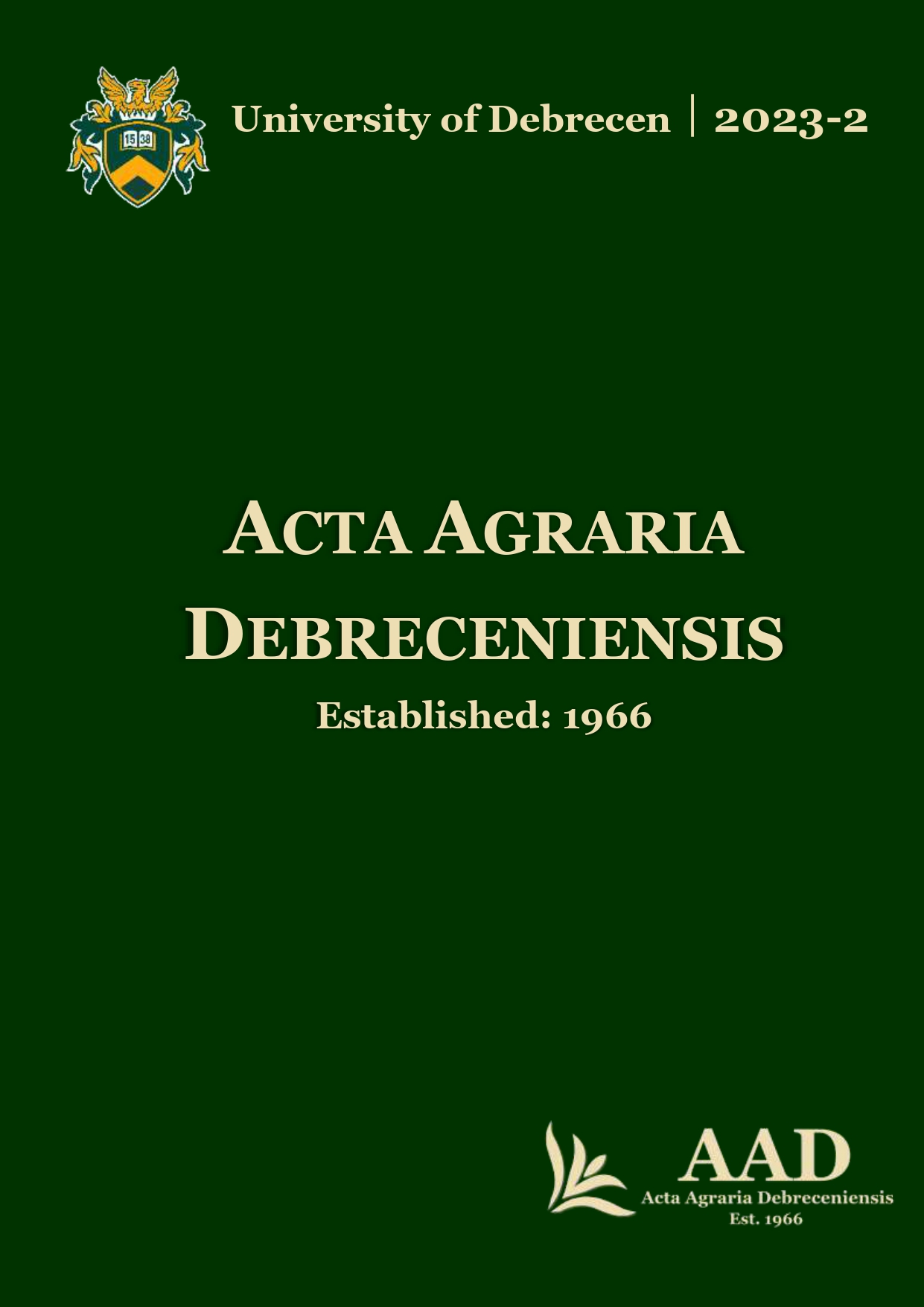The impact of population management on urban and rural Hooded Crow populations
Authors
View
Keywords
License
Copyright (c) 2023 by the Author(s)

This work is licensed under a Creative Commons Attribution 4.0 International License.
How To Cite
Accepted 2023-10-02
Published 2023-12-01
Abstract
Hooded Crow (Corvus cornix), originally native to agricultural areas, has become widespread in urban areas in recent decades. However, this process has negative consequences on urban animals and humans. Due to these problems, the control of urban crow populations is needed. Crows also cause significant damage to wildlife management, and are constantly being controlled in rural areas as well. In this study, we compare rural and urban populations to find out whether hunting activities have a population reduction effect. In the rural population, the reduction is carried out by weapons and traps, while the urban crows are controlled using traps only. In both sample areas, crow nests were surveyed during the nesting period. 29 active nests were monitored in the rural area in 2021, and 39 in 2022. In the urban area, 44 nests were recorded in 2021 and 35 nests in 2022. In 2021, 30 individuals were removed in the rural area, and 84 in 2022. In the urban area, 223 individuals were removed in 2021 and 144 in 2022. Results show that the number of crows removed follows the number of active nests, so that the reduction of a given year is likely to have an effect on the following year's nesting population. Because traps mostly capture juvenile birds, reducing the breeding population in the city can only be achieved in the long-term. Considering this, it is likely that increased attention to population control can effectively maintain crow populations and reduce the problems they cause.
References
- Ahmed, H.A.A.–Issa, M.A.–Eisa, Y.A. (2018): determination of Hooded Crow (Corvus Corone L.) population and methods of control in sheep farm at Ras Sedr, South Sinai, Egypt. Egypt. J. Agric. Res., 96(4), pp. 1351–1359. http://dx.doi.org/10.21608/ejar.2018.142667
- Amar, A.–Burthe, S. (2001): Observations of predation of Hen Harrier nestling by Hooded Crows in Orkney. Scott. Birds 2001, 22, 65–66.
- Emery, N.J.–Clayton, N. (2004): The Mentality of Crows: Convergent Evolution of Intelligence in Corvids and Apes. Science, 306, pp. 1903–1907. https://psycnet.apa.org/doi/10.1126/science.1098410
- Faragó, S.–Kovács, Gy.–Hajas, P.P. (2017): Management plan for Hooded Crow (Corvus cornix) in Hungary. Hungarian Small Game Bulletin, 13, pp. 15–48. http://dx.doi.org/10.17243/mavk.2017.015
- Kabadayi, C.–Osvath, M. (2017): Ravens parallel great apes in flexible planning for tool-use and bartering. Science, 357, pp. 202–204. https://doi.org/10.1126/science.aam8138
- Kallioniemi, H.–Väänänen, V-M.–Nummi P.–Virtanen J. (2015): Bird quality, origin and predation level affect survival and reproduction of translocated common pheasants Phasianus colchicus. Wildlife Biology, 21(5), pp. 269–276. https://doi.org/10.2981/wlb.00052
- Kövér, L.–Gyüre, P.–Balogh, P.–Huettmann, F.–Lengyel, Sz.–Juhász, L. (2015): Recent colonization and nest site selection of the Hooded Crow (Corvus corone cornix L.) in an urban environment. Landscape Urban Planing, 133, pp. 78–86. https://dx.doi.org/10.1016/j.landurbplan.2014.09.008
- Kövér, L.–Juhász, L. (2012): A dolmányos varjú (Corvus cornix L.) színes gyűrűs jelölésének módszertana és az előzetes eredmények. Agrártudományi közlemények, 48, pp. 43–48. https://doi.org/10.34101/actaagrar/48/2451
- Kövér, L–Tóth, N–Lengyel, Sz.–Juhász, L. (2018): Corvid control in urban environments: a comparison of trap types. North-Western Journal Of Zoology, 14(1), pp. 85–90.
- Kövér, L.–Paládi, P.–Benmazouz, I.–Šorgo, A.–Špur, N.–Juhász, L.–Czine, P.–Balogh, P.–Lengyel, Sz. (2022): Is the Hitchcock Story Really True? Public Opinion on Hooded Crows in Cities as Input to Management ANIMALS, 12(9), 1207, 18 p. https://doi.org/10.3390/ani12091207
- Kurosawa, R.–Kono, R.–Kondo, T.–Kanai, Y. (2003): Diet of jungle crows in an urban landscape. Global Environmental Research, 7, pp. 193–198.
- Marzluff, J.M.–Clucas, B.–Oleyar, M.D.–DeLap, J. (2016): The causal response of avian communities to suburban development: a quasi-experimental, longitudinal study. Urban Ecosyst, 19, pp. 1597–1621. DOI 10.1007/s11252-015-0483-3
- McIvor, G.E.–Healy, S.D. (2017): Nest site selection and patterns of nest re-use in the Hooded Crow Corvus cornix. Bird Study, 64(3), pp. 374–386. https://doi.org/10.1080/00063657.2017.1364220
- Paládi, P.–Tóth, D.–Lengyel, Sz,–Juhász, L.–Kövér, L. (2017): Dolmányos varjak (Corvus cornix Linnaeus, 1758) szárnybilétás jelölése Debrecenben. Természetvédelmi Közlemények, 23, pp. 68–79. https://dx.doi.org/10.20332/tvk-jnatconserv.2017.23.68
- Pokorny, B.–Flajšman, K.–Jelenko, I. (2014): The importance and impacts of crows, with emphasis on Hooded Crow (Corvus cornix), in the (sub)urban environment. Acta Silvae et Ligni 103(2014), pp. 47–60.
- Rodewald, A.D.–Kearns, L.J.–Shustack, D.P. (2013): Consequences of urbanizing landscapes to reproductive performance of birds in remnant forests. Biological Conservation, 160, pp. 32–39. https://doi.org/10.1016/j.biocon.2012.12.034
- Špur, N.–Pokorny, B.–Šorgo, A. (2016): Attitudes toward and Acceptability of Management Strategies for a Population of Hooded Crows (Corvus cornix) in Slovenia, Anthrozoös, 29(4), pp. 669–682. http://dx.doi.org/10.1080/08927936.2016.1228766
- Szép, T.–Csörgő, T.–Halmos, G.–Lovászi, P.–Nagy, K.–Schmidt, A. (2022): Magyarország madáratlasza, 2. javított és kiegészített kiadás, Agrárminisztérium, Magyar Madártani és Természetvédelmi Egyesület, Budapest
- Taylor, A.H. (2014): Corvid cognition. WIREs Cognitive Science, 5, pp. 361–372. https://doi.org/10.1002/wcs.1286
- Tsachalidis, E.–Sokos, C.–Birtsas, P.–Patsikas, N. (2006): The Australian Crow Trap and the Larsen Trap: Their capture success in Greece. Proceedings of the 2006 Naxos International Conference on Sustainable Management and Development of Mountainous and Island Areas. Vol. II., pp. 325–329.
- Vrezec, A. (2010): Historical occurrence of the Hooded/Carrion Crow (Corvus cornix/corone) in urban areas of Europe with emphasis on Slovenia. Annales Ser. Hist. Nat., 20(2), pp. 131–140.
- Vuorisalo, T.–Andersson, H.–Hugg, T.–Lahtinen, R.–Laaksonen, H.–Lehikonen, E. (2003): Urban development from an avian perspective: Causes of hooded crow (Corvus corone cornix) urbanisation in two Finnish cities. Landscape Urban Planing. 62(2), pp. 69–87. https://doi.org/10.1016/S0169-2046(02)00124-X
- Zduniak, P. (2006): The prey of Hooded Crow (Corvus cornix L.) in wetland: study of damaged egg shells of birds. Polish Journal of Ecology, 54(3), pp. 491–498.

 https://doi.org/10.34101/actaagrar/2/13015
https://doi.org/10.34101/actaagrar/2/13015